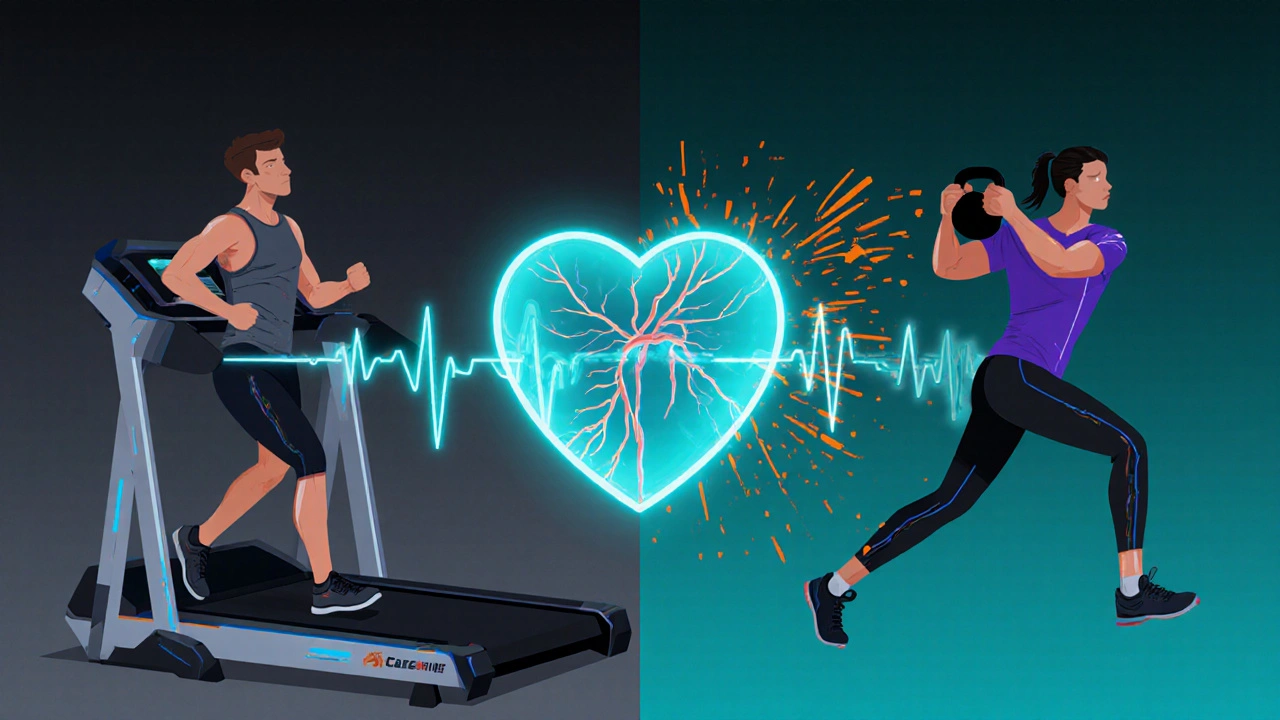Exercise Benefits for Lowering Hypertension Risk
 Oct, 4 2025
Oct, 4 2025
Blood Pressure Reduction Calculator
Estimated Blood Pressure Reduction
When you hear that exercise is a key tool for keeping blood pressure in check, the claim isn’t hype - it’s backed by decades of research. Regular physical activity can shave off enough pressure to move you from a high‑risk bracket into a safer zone, and it does so without a prescription.
Key Takeaways
- Moderate aerobic activity can lower systolic pressure by 4‑9mmHg on average.
- Combining cardio with resistance training yields the biggest long‑term gains.
- 150 minutes of moderate or 75 minutes of vigorous activity each week meets most health‑agency guidelines.
- Even short bursts - 10‑minute walks - start to improve artery flexibility.
- Tracking progress with a home cuff or wearable helps you stay motivated.
How Exercise Lowers Blood Pressure
Understanding the why helps you stick with the how. Physical activity influences three main mechanisms:
- Vascular tone regulation: Moving muscles demand more oxygen, prompting blood vessels to widen (vasodilation). This reduces resistance against which the heart must pump.
- Hormonal balance: Exercise lowers levels of stress hormones like adrenaline and cortisol, both of which can spike blood pressure.
- Improved insulin sensitivity: Better glucose handling reduces the strain on blood vessels, indirectly supporting lower pressure.
In short, the heart works easier, the arteries stay flexible, and the whole system stays calmer.
Types of Exercise and Their Impact
Not all workouts affect blood pressure equally. Below is a quick snapshot of the two most studied categories.
| Exercise Type | Typical Session Length | Average BP Reduction (mmHg) | Key Mechanism |
|---|---|---|---|
| Aerobic Exercise | 30‑60min (moderate) or 20‑30min (vigorous) | 4‑9 systolic, 2‑5 diastolic | Enhanced endothelial function, reduced arterial stiffness |
| Resistance Training | 20‑45min, 2‑3 sessions/week | 3‑7 systolic, 1‑4 diastolic | Increased muscle mass improves vascular compliance |
| Combined (Cardio + Strength) | 45‑75min total, 3‑5 days/week | 6‑12 systolic, 3‑6 diastolic | Synergistic hormonal and mechanical benefits |
Research from the Australian Heart Foundation and the WHO shows the combined approach delivers the steepest drop, but if you’re pressed for time, even pure aerobic work moves the needle.

Recommended Frequency, Intensity, and Duration
The World Health Organization (WHO) advises adults aim for at least 150minutes of moderate‑intensity or 75minutes of vigorous‑intensity aerobic activity per week, plus two days of muscle‑strengthening moves. The Australian Heart Foundation aligns with these numbers but adds a “step‑up” for people over 45 or with family‑history hypertension: 200minutes of moderate activity.
Intensity can be gauged by the talk test - you should be able to speak in short sentences but not sing. For those using wearables, aim for 64‑76% of maximum heart rate (220-age) during moderate sessions.
Practical Tips to Get Started
- Pick activities you enjoy: brisk walking, cycling, dancing, or even gardening count.
- Start small: three 10‑minute walks a day are easier to adopt than a single 30‑minute jog.
- Schedule it: block the same time slot on your calendar as you would a meeting.
- Mix it up: alternate 2 days of cardio with 1 day of strength (bodyweight squats, push‑ups, resistance bands).
- Track progress: a simple home cuff or a smartwatch lets you see trends, reinforcing the habit.
Remember, the goal isn’t to push yourself to exhaustion. Consistency beats intensity when it comes to blood pressure control.
Common Pitfalls & How to Avoid Them
Many people start strong but drop off. Here’s what usually trips folks up:
- Doing too much, too fast: sudden spikes in activity can cause temporary BP spikes. Gradual ramps prevent this.
- Skipping warm‑up/cool‑down: 5‑minute light activity before and after each session helps maintain stable vascular tone.
- Neglecting resistance work: focusing only on cardio misses out on muscle‑mediated benefits.
- Ignoring salt and caffeine: even the best workout can be offset by high sodium intake.
- Not checking pressure: without measurements you can’t know if you’re moving the needle.
Address each by adding a brief warm‑up walk, scheduling two strength days, and keeping a food‑log alongside your workout tracker.
Monitoring Progress and When to Seek Medical Advice
Blood pressure isn’t a static number. Aim to measure it at the same time each day (morning before coffee is ideal). A reduction of 5‑10mmHg after 4‑6 weeks of regular activity signals you’re on the right track.
If you notice:
- Persistent readings above 140/90mmHg despite exercise,
- Dizziness, fainting, or chest pain during activity,
- Rapid heart rates >120bpm at moderate effort,
schedule a check‑up. Your doctor may adjust medication or suggest a tailored cardiac rehab program.

Frequently Asked Questions
How quickly can exercise lower blood pressure?
Most studies show a measurable drop within 4‑6 weeks of consistent activity, with the biggest change occurring in the first two months.
Is walking enough to treat hypertension?
Walking at a brisk pace (about 3‑4mph) for 30minutes most days meets moderate‑intensity guidelines and can lower systolic pressure by 4‑6mmHg. Adding a couple of strength sessions boosts the effect.
Can I exercise if I’m on blood‑pressure medication?
Yes, exercise complements medication. However, start at lower intensity and monitor how your meds affect heart rate. Talk to your doctor before making major changes.
What’s the best time of day to work out for blood pressure?
Morning sessions often produce a more sustained overnight BP reduction, but consistency matters more than the exact hour. Choose a time you can stick to.
Do I need a gym membership?
No. Bodyweight circuits, resistance bands, and outdoor cardio are all effective and free. The key is to keep the heart moving and the muscles working.

Laneeka Mcrae
October 4, 2025 AT 15:02From a physiological standpoint, regular cardio creates lasting vasodilation, which directly cuts peripheral resistance. Pair that with twice‑weekly resistance work and you gain muscular tone that further eases arterial pressure. Even short, brisk walks can trigger these mechanisms if done consistently. The net effect is a measurable drop in systolic numbers over weeks.
Robert Frith
October 6, 2025 AT 23:30Oi mate, thinkin’ a cuppa’ll fix your blood pressure? Nah, you need to get off the sofa and smash some cardio, even if it’s just joggin’ around the block. And don’t forget a couple of push‑ups – they ain’t just for the lads!
Albert Gesierich
October 9, 2025 AT 07:59The article correctly cites the range of 4‑9 mmHg reduction, yet it occasionally omits the plural 'minutes' when referring to aerobic durations. Precise language matters because readers may otherwise misinterpret dosage. Also, the phrase 'combined approach delivers the steepest drop' should be followed by a citation to validate the claim.
Brad Tollefson
October 11, 2025 AT 16:27Honestly, just keep it chill. A 30‑minute walk after work feels like a break, and you won’t even notice the blood pressure benefits until later. Consistency beats intensity any day. Plus, it’s a great excuse to listen to your favorite podcasts.
Paul van de Runstraat
October 14, 2025 AT 00:55Sure, you could follow the WHO guidelines to the letter, but why not spice it up with a dance class or a backyard boot‑camp? It’s amazing how a little variety keeps the motivation alive, and the arteries thank you for the surprise.
Suraj Midya
October 16, 2025 AT 09:23For anyone who thinks skipping exercise is a patriotic act, think again – a healthy nation starts with healthy citizens. The moral duty to lower hypertension is as important as any flag‑waving ceremony. Ignoring proven benefits is practically a betrayal of public health.
ashish ghone
October 18, 2025 AT 17:51Starting a fitness routine can feel intimidating, but the first step is simply showing up for a short session.
Consistency is the hidden hero behind every drop in blood pressure, because the body adapts gradually to the stress of movement.
When you log a 10‑minute walk three times a day, you’re already in the zone that promotes vasodilation.
Adding resistance bands on alternate days builds muscle, which improves vascular compliance and supports lower systolic numbers.
Don’t worry about perfect form at the beginning; focus on getting the movement pattern right and progress from there.
Monitoring your progress with a simple cuff or a smartwatch can provide instant feedback, reinforcing the habit.
Remember that the heart loves a warm‑up, so spend five minutes on gentle marching or arm circles before the main effort.
Cool‑down with slow stretching helps maintain stable blood flow and prevents a post‑exercise spike.
Nutrition plays a role too – keep sodium low and stay hydrated to let the workout do its job.
If you feel a sudden dizziness, slow down or pause; the goal is steady improvement, not a frantic race.
Celebrate small victories, like a 2 mmHg drop after a month, because every point counts toward long‑term health.
Set realistic weekly goals: 150 minutes of moderate cardio plus two strengthening sessions is a solid baseline.
Mix activities you enjoy, whether it’s cycling, dancing, or gardening, to keep the routine fresh.
Invite a friend or join an online community for accountability – social support is a proven motivator.
Stay patient; the body may take 4‑6 weeks to reflect noticeable changes, but the habit will stay with you.
Keep smiling, stay active, and your blood pressure will thank you. 😊
steph carr
October 21, 2025 AT 02:20Got you covered – even a quick evening stroll can be the catalyst for long‑term improvement, and it fits into any busy schedule.
Vera Barnwell
October 23, 2025 AT 10:48While the science behind exercise and blood pressure is solid, some whisper that big pharma downplays natural methods to keep medication sales high. Regardless of that shadowy agenda, the data still shows that a steady routine of cardio and strength work can shave off those risky mmHg numbers. So, don’t let the conspiratorial noise stop you from moving.
David Ross
October 25, 2025 AT 19:16Incorporating regular aerobic activity, such as brisk walking, cycling, or swimming, not only enhances cardiovascular efficiency, but also reduces systemic vascular resistance, thereby lowering systolic pressure; subsequently, coupling this with resistance training improves muscular strength, which contributes to better arterial compliance, and together these modalities create a synergistic effect that sustains long‑term blood pressure control, especially when monitored consistently over weeks.
Henry Seaton
October 28, 2025 AT 03:44Do the cardio and the weights, that's it.
Baby Thingie
October 30, 2025 AT 12:13Exercise reduces systolic pressure by up to twelve millimetres of mercury.
Abby Elizabeth
November 1, 2025 AT 20:41Ugh, another article telling me to jog, as if I haven't heard that a thousand times, and now they throw in a table that looks like a school project.
Mark Haycox
November 4, 2025 AT 05:09The narrative glorifies activity while conveniently ignoring the socioeconomic barriers that prevent many from accessing safe spaces for exercise, making the whole argument feel like elitist propaganda.
Michael Taylor
November 6, 2025 AT 13:37Honestly, if you follow the recommended 150 minutes of moderate cardio, sprinkle in two days of resistance work, and keep a casual eye on your numbers, you're basically ticking the boxes of good health; however, remember that life throws curveballs, so flexibility in your routine is key, and if you ever feel like the progress stalls, perhaps revisit the intensity or try a new sport to keep things interesting; after all, sustainability beats perfection any day.
Troy Brandt
November 8, 2025 AT 22:06Seeing the detailed breakdown of aerobic versus resistance benefits helps clarify why a mixed program tends to outperform single‑modality workouts, and it also highlights the importance of adjusting intensity based on personal fitness levels to maximize blood pressure improvements without overexertion.
Barbra Wittman
November 11, 2025 AT 06:34While the advice to mix dance classes and boot‑camps sounds lively, it's worth noting that beginners should start with low‑impact options to avoid injury, otherwise the enthusiasm may backfire.
Gena Thornton
November 13, 2025 AT 15:02Adding to the point about civic responsibility, community‑based walking groups can bridge the gap between national pride and personal health, offering collective motivation and measurable blood pressure benefits.